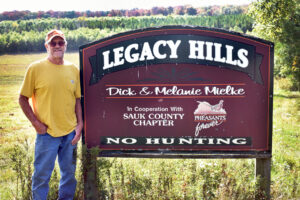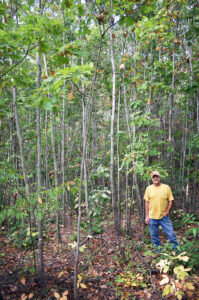
Dick Mielke was born and raised on farmland east of the city of Baraboo, and still lives on the land. He has converted much of it into carefully tended Managed Forest Law property he and his wife call “Legacy Hills.” / Photo Credit: Wisconsin DNR
By Art Kabelowsky, DNR Forest Health Outreach/Communications, Fitchburg;
Arthur.Kabelowsky@wisconsin.gov; 608-335-0167
BARABOO TOWNSHIP — This land has been Dick Mielke’s legacy since the day he was born.
On a warm October morning, Mielke gave a visitor a tour of his property located four miles west of the city of Baraboo in Sauk County. Along the way, he pointed out landmarks that have played pivotal roles in the story of his life.
“If you look over there, you can barely see the house I grew up in, behind those trees. There’s a window. Oops, now it’s gone,” Mielke said while driving an ATV along a logging path on the edge of a tree stand. He and his wife, Melanie, now live in a comfortable ranch-style home they built on the property in 1990.
“My grandfather settled here from Germany right around 1900 … My family has been on the property ever since,” Mielke said.
Later, Mielke pointed to a small building across the street from his land: “That’s where I went to school. It was a one-room schoolhouse,” he said.
And all around him stands a diverse and carefully planned ecoculture of tree stands, prairie, a little food-crop growth and resident wildlife.
A sign on the edge of the property christens the place “Legacy Hills.” It’s safe to say it’s Mielke’s favorite place.
“I’ve basically been out in the woods for 60 years,” he said.

Dick Mielke of the Town of Baraboo shows off the success a recent round of seedling plantings has produced on his Managed Forest Law land. / Photo Credit: Wisconsin DNR
Clearly, Mielke feels close ties to the land he and his father previously worked, first as dairy farmers and then as cattle producers.
And, clearly, Mielke is proud of the stewardship — a fancy term for hard work — he continues to bring to about 72 acres of his property under a partnership of the Wisconsin Department of Natural Resources’ (DNR) Managed Forest Law (MFL) program.
“Our initial 25-year contract was done in 1988, so it was a couple weeks ago,” Mielke said with a smile. “When we did some logging in those woods in the late 80s, the forester recommended [the MFL program].”
Mielke said he did some research, contacted his DNR forester and decided to come on board. “The original contract was for the main woods, 50 to 60 acres. That was renewed, and later on we added to it.”
Portions of the property also are under the DNR Forest Legacy Conservation Easement program.
“Dick is a different breed,” said Allen King, a tax law forestry specialist with the DNR. “He’s a model landowner. He does everything that we ask of him and then some.
“The only time he really asks for help is when he’s looking for validation that he’s on the right track.”
Mielke doesn’t see the recommendations and requirements of the program as a bother.
“Over the years, my experience with the MFL is it’s an easy program for me to participate in. There aren’t a lot of demands outside of what I would normally do anyway. What the DNR asks us to do was what we were going to do anyway to take care of the land,” Mielke said. “It’s a long-term commitment kind of thing, and if I can get some assistance, it just makes sense.
“It might be an obstacle for a person who can’t do it or doesn’t know how or doesn’t have the equipment,” Mielke said. “These days you run across more people who don’t do anything with their woods but treat it as a vacant lot.”
Mielke acknowledges that he spends a lot of time making things better in his stands and on his property.
How much time? “That’d be a good question to ask my wife,” he said with a laugh. “Once the weather cools down, I spend a disproportionate amount of time out here.”
“We use his property as a show piece of forestry in the Driftless area,” King said. “Dick is unique in that he’s willing to do all the work involved and also willing to allow us to use his property as a showpiece for field days, training and walk-throughs.”
Mielke said his work under the MFL program has included “a lot of TSI (timber stand improvement) and control of invasives.”
“We’ve harvested a couple of times — the last one was 2018 and 2019. We took 51,000 board feet,” he said. “It was mostly maple, some red and white oak, and we took out quite a bit of ash because of emerald ash borer.”
Just a few years later, tree regeneration in those areas is “coming back nicely,” Mielke said, even though “we didn’t plant (seeds or seedlings) back in there because everything is so thick.”
Before long, Mielke says he’ll use the advice of the DNR’s Sauk County foresters to determine when to thin out the regenerating stands to give the strongest trees a chance to thrive.
“The county foresters always have been helpful,” he said. “Even last winter, our present county forester came out and gave me help thinning out some white pine stands.”
For the last few years, Mielke has been executing a plan to perform non-commercial thinning of some hardwood and conifer plantations.
“We originally put those in about 20 years ago. Multiple small stands — the majority were direct-seeded walnut and oak,” Mielke said. “It adds up to about 10 acres. It’s coming along well.”
There’s also a large prairie area easily seen on County Hwy. W, although some changes came to that 18-acre area this year.
“With the drought this year, Sauk County released all the CRP (Conservation Reserve Program) land and a neighbor asked to mow for feed,” Mielke said. “I got permission to mow and bale 50 percent and the other 50 percent was mowed 18 inches high.
“The NRCS (Natural Resources Conservation Service) office let me know we needed to do something about the goldenrod there, and hopefully next year it will be much reduced.”
In the 1990s, Mielke said he allowed the University of Wisconsin to hold a red oak regeneration project on his land. “They were out here two or three times a month. They decided maples take over red oaks,” he said — with the glint in his eye hinting that he could have told them that.
The long-term impact of Mielke’s long hours of work make an impression on him from time to time, reminding him that he’s doing what’s best for his land and the environment.
“He certainly takes pride in his property,” King said.
“Every time you’re out here, you think ‘wow, this was open land 20 years ago,” Mielke said. “And now, it’s so different.”
